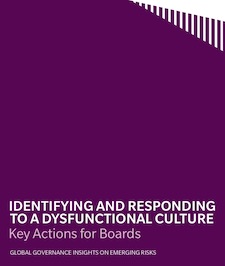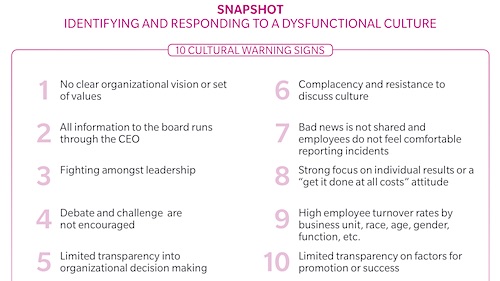Avoiding the pitfalls of a dysfunctional corporate culture is becoming an increasingly important issue in the boardrooms of companies around the world, according to a new report conducted by Marsh & McLennan Companies with input from WomenCorporateDirectors.
 |
“A dysfunctional or toxic culture creates inefficiencies and daily instances of underperformance across the organization,” said WomenCorporateDirectors CEO Susan Keating. It also leaves many employees looking for a way out. For example, the report says that 80 percent of women who report sexual harassment change jobs within two years.
That can have a serious effect on an organization’s bottom line. Citing numbers from human resources firm Mercer, the study notes that 43 percent of M&MC transactions worldwide experienced serious cultural misalignment that caused deals to be delayed or terminated or purchase prices to be negatively impacted.
Because of this, boards are being pressed to focus more of their attention on culture-related issues. MMC interviewed corporate directors to find out what they saw as the signs that a company may be developing a toxic culture. It also asked them for some pointers about how organizations can take action to rectify any problems.
The first danger sign is not having a clear organizational vision or set of values. Several other top indicators also address executive leadership. “Fighting amongst leadership” was cited, as was “debate and challenge are not encouraged” and “all information runs through the CEO.”
A lack of openness was behind several other warning flags as well. Limited transparency into both organizational decision-making and factors for promotion and success were mentioned. “Bad news is not shared and employees do not feel comfortable reporting incidents” was also on the list.

To take action against these problems, the survey respondents made several suggestions. Making sure that cultural issues were a major consideration in the selection of a CEO was one, as was ensuring that culture was a regularly scheduled board agenda item. As regards pay-related issues, they suggested considering how culture-related elements are factors in the organization’s executive compensation.
Respondents also stressed the importance of board members making the effort to communicate outside the boardroom. “Build relationships beyond the C-suite” and “visit sites to better understand day-to-day operations” were listed as priorities. Also, keeping in touch with the organization’s external reputation through channels such as social media was recommended.
“These warning signs provide a starting point for discussion,” said WCD lead director Kapila Anand. “What is built coming out of this can make the organization more resilient, more innovative, and more attractive to the talent you want to keep and recruit.”
To read all of “Identifying and Responding to a Dysfunctional Corporate Culture,” click here.


 Business leaders will face challenges in the upcoming year, some of which will come as a complete surprise, or beyond anyone's imagination.
Business leaders will face challenges in the upcoming year, some of which will come as a complete surprise, or beyond anyone's imagination. Teneo has hired Philipp Grontzki, who is a 20-year veteran of corporate communications and financial journalism, as a managing director in its strategy and communications group.
Teneo has hired Philipp Grontzki, who is a 20-year veteran of corporate communications and financial journalism, as a managing director in its strategy and communications group. Rowan Benecke, who co-founded Zeno Group and helmed Burson-Marsteller's tech practice, has joined McKinsey & Co as director of communications for North America.
Rowan Benecke, who co-founded Zeno Group and helmed Burson-Marsteller's tech practice, has joined McKinsey & Co as director of communications for North America. BCW has named Golin's Matt Coldagelli EVP and leader of its corporate affairs practice in Chicago.
BCW has named Golin's Matt Coldagelli EVP and leader of its corporate affairs practice in Chicago. Abby Bailey, who headed corporate communications for Fedex in its Middle East, India and Africa region, has joined Teneo as managing director in Dubai.
Abby Bailey, who headed corporate communications for Fedex in its Middle East, India and Africa region, has joined Teneo as managing director in Dubai.


 Have a comment? Send it to
Have a comment? Send it to 
No comments have been submitted for this story yet.